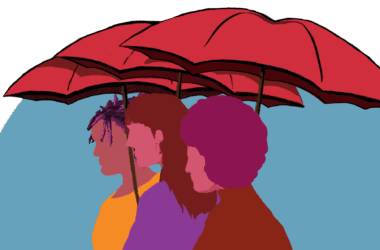One would be hard-pressed to find two places with less in common than southern Bhutan and the town of Saint-Jérôme. In the south of Bhutan, the soaring peaks of the Himalayas descend into subtropical plains and fields of rice. Bhutan is primarily Buddhist and shares many cultural ties with its northern neighbour, Tibet. It was one of the last countries in the world to open itself up to outside influence, remaining isolated until well into the 20th century. TV and the Internet were banned there until 1999.
Saint-Jérôme, too, is at the gateway to a mountain range – albeit the slightly more humble Laurentians. The similarities, however, stop there. Saint-Jérôme is in many ways a typical Quebec town, blending the old – Catholic churches and traditional limestone buildings – with the new – Wal-Mart, fast -food restaurants, and modern housing developments. Both geographically and culturally, it’s about as far as you can get from Bhutan. Yet Saint-Jérôme is exactly where Nandu Bastola, a refugee from southern Bhutan, has found himself. Just over a year ago, he and his family were resettled by the Canadian government after almost 17 years in a refugee camp in Nepal.
The plight of refugees from Bhutan is not well known, but Bastola’s story is all too common: more than 25,000 Bhutanese refugees have been resettled in North America, Europe, Australia, and New Zealand in the last few years. As it became clearer that their government didn’t want them back and their chances of returning home almost completely disappeared, Bastola and others like him decided to accept the offer of resettlement and start new lives in a foreign land.
When Bastola fled his home in 1991, ethnic tensions and government crackdowns on opposition groups were rampant across the south of the country.
“I was a student at the time – only 15 years old,” Bastola says. “When I left Bhutan I didn’t know much about the political issues, but I understood [some of the situation] from my parents.
“My whole family left for Nepal, and we went to the Jhapa district [in southeastern Nepal],” where they ended up in a refugee camp, Bastola says. “In the beginning we were living on the bank of a river in Jhapa. We had very little food; we didn’t have enough of anything. The situation was bad. Many people got sick with dysentery. But after that the UNHCR [the U.N.’s refugee agency] began to improve the situation in the camp: they provided food rations, education, and health facilities.”
Bastola comes from the Nepali-speaking ethnic minority that makes up the bulk of the population in Bhutan’s southern districts. These Nepali Bhutanese share not only their language, but also their religion – Hinduism, as opposed to Buddhism, the official state religion in Bhutan – and many cultural practices with Nepali speakers in northern India and Nepal itself. They are the descendants of migrant workers brought to Bhutan to work the land hundreds of years ago. For Bastola and the other refugees, though, Bhutan is still their homeland. Despite spending more than half his life in a Nepalese refugee camp, Bastola, like almost all of the refugees, was never given the opportunity to apply for Nepalese citizenship.
The rest of the Bhutanese population is much closer – ethnically, linguistically, and culturally – to their neighbours to the north, the Tibetans. The king and most of the government and civil service are members of this group, and they have, understandably, always been keen to protect their culture from outside influences. This sentiment has guided Bhutanese policy toward their sizable Nepali minority, which by some accounts makes up close to half the population. Many within the ruling elite saw this large minority as a threat, and thus created policies aimed at “Bhutanizing” citizens like Bastola.
Many Nepali speakers, however, saw the government as trying to marginalize them and force them to give up their language and culture. Tensions came to a head in the late 1980s and early 1990s when more and more Nepali Bhutanese protested these policies and the government responded by cracking down. Labelling the protestors as anti-nationals, the government threw thousands in jail, torturing many activists along the way. Some Nepali Bhutanese fled the country, and others were effectively stripped of their citizenship and kicked out of Bhutan regardless of whether they were involved in anti-government activity.
By 1993, over 80,000 people had left Bhutan, with most of them ending up in U.N.-administered refugee camps in eastern Nepal. Bastola was one of these migrants. After he left his home he was brought to the refugee camp, where he spent the next 17 years.
“We had Bhutanese citizenship,” he says. “We had the papers and the tax receipts in Bhutan, but when I came to Nepal we had nothing.”
Bhutan would not allow him to re-enter, and Nepal would not allow him to settle outside of the camp. Bastola was living in the stateless purgatory that characterizes the life of a refugee.
By the early 2000s, the number of refugees languishing in camps in Nepal had swollen to just under 110,000. Considering the total number of Bhutanese is estimated at fewer than 700,000, these refugees constitute a sizable chunk of the population. In 2006, with neither Bhutan nor Nepal willing to re-integrate them, the United States and a number of other nations stepped forward with a plan to resettle the refugees in third countries. The U.S. offered to resettle 60,000 Bhutanese refugees, while Canada offered to take 5,000.
The plan was controversial within the camps, and many refugees believed it would end their hopes of returning home. Yet many others saw third-country resettlement as an opportunity to build a new life and accepted that they would not be able to return to Bhutan. Bastola was among the latter.
“We arrived in Canada on December 8, 2008, and the resettlement process began in the beginning of 2008. Representatives of the Canadian government interviewed us [at the time] about coming to Canada,” and later worked with them throughout the process, he says.
In 2008, Bastola arrived in Montreal with his wife and their two children. Soon after that they were settled in an apartment in Saint-Jérôme, their new home. The Bastolas were among the first Bhutanese refugees to be resettled in Canada. By the end of 2009, more than 850 had been resettled in towns and cities across the country, from Vancouver to St. John’s.
The adjustment to the country was difficult, admits Bastola. Almost everything about Canada was alien, from the harsh winter weather to the unfamiliar food. Bastola struggled especially with language. Before coming to Quebec he spoke very little English and no French. Now, learning the language of his adopted land is a top priority.
“When we came here we knew no French,” Bastola says. “In the other provinces, English is the [main language], but we understand that here French is very important, almost compulsory. The language is very difficult. In the beginning it was hard even to go shopping … but we’re learning.”
Along with his wife and the other adults among the refugee population in Saint-Jérôme, Bastola attends full-time French language classes. However, communication in anything but his native Nepali is still difficult. The children are enrolled in the local public school, and are working hard to learn French as well.
While the government provides his family with financial help, the long-term goal for Bastola is to move into the workforce and establish a degree of self-sufficiency. Perhaps the most important thing for Bastola is that his children have an opportunity to improve their future, an opportunity they never would have had if they’d continued to grow up in the refugee camp.
“When we had the chance to come to Canada,” he says, “We hoped it would mean a better future for us.”






